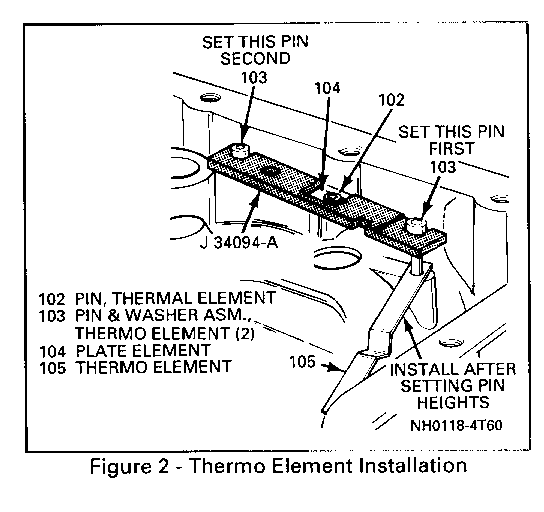NEW THERMO ELEMENT & PIN HEIGHT SETTING PROCEDURE

Subject: NEW THERMO ELEMENT AND PIN HEIGHT SETTING PROCEDURE
Model and Year: 1985-90 CELEBRITY AND 1990-91 LUMINA WITH 4T60 AUTOMATIC TRANSMISSION 1991 LUMINA (Z34 ONLY) WITH 4T60-E AUTOMATIC TRANSMISSION
TO: ALL CHEVROLET DEALERS
BULLETIN COVERS: (Figure 1)
A new thermo element that contains an additional open slot (instead of a hole) so the element can be installed after setting the height of both pins. Installing the thermo element after setting the height of both pins could help reduce the potential of damage, which can change the cold-to-hot fluid level calibration during the installation. This will help prevent durability concerns associated with incorrect fluid levels. The new thermo element can be used on all previous model HYDRA-MATIC 4T60, HYDRA-MATIC 4T60-E and THM F-7 transaxles.
IMPORTANT:
When reading the fluid level indicator, check both sides to ensure the reading is accurate and not a false reading caused by the rotating parts splashing fluid onto the indicator. A false reading could show a very low reading on the indicator when, in fact, the true fluid level is below the end of the indicator.
SERVICE PROCEDURE: (Figures 1 and 2)
Refer to the following procedure whenever the height setting of both pins for this new thermo element is necessary.
1. Set the middle thermo pin (102 or '123) height with J 34094-A.
2. Install the element plate (104 or '122).
3. Install the pins and washers (103 or *120) using J 34094-A to set the height of both washers. First, set the pin that is furthest from the accumulators. Then set the other pin. This will ensure that both pins will be set correctly.
4. Carefully install the thermo element between the two pins without bending the element too much. "V" in Thermo Element MUST Contact the element plate.
Referenced part illustration numbers are for HYDRA-MATIC 4T60-E only.
DATE OF PRODUCTION CHANGE:
Beginning November 16, 1990 (Julian Date 320), all 1991 HYDRA-MATIC 4T60, 4T60-E and THM F-7 transaxles were built with the new thermo element. Some models may have the new thermo element prior to the production change date listed above.
SERVICE PARTS INFORMATION:
The new thermo element will be in the thermo element package when the stock of the previous thermo element is depleted.
NOTICE: Do not try to modify the previous thermo element to the new element - this will change the calibration of the fluid level in the transaxle bottom pan and could cause a durability concern.


General Motors bulletins are intended for use by professional technicians, not a "do-it-yourselfer". They are written to inform those technicians of conditions that may occur on some vehicles, or to provide information that could assist in the proper service of a vehicle. Properly trained technicians have the equipment, tools, safety instructions and know-how to do a job properly and safely. If a condition is described, do not assume that the bulletin applies to your vehicle, or that your vehicle will have that condition. See a General Motors dealer servicing your brand of General Motors vehicle for information on whether your vehicle may benefit from the information.
